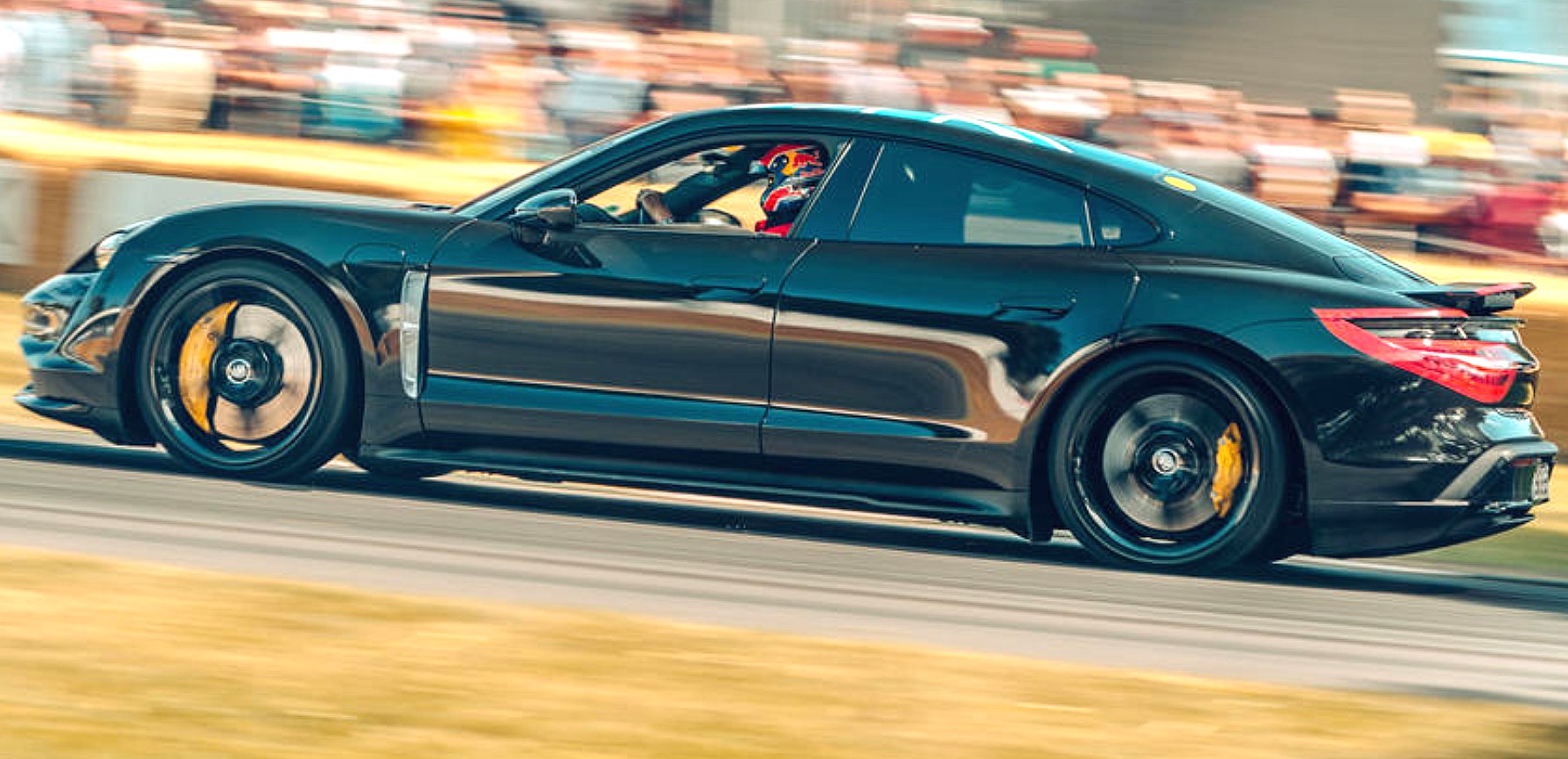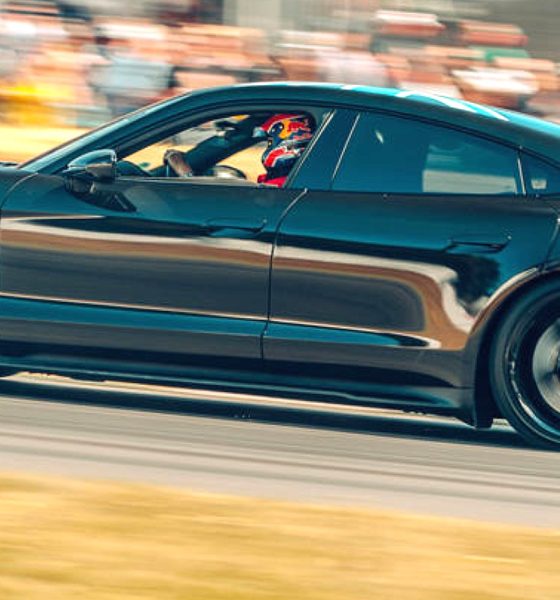

News
Porsche Taycan to get ‘Turbo S’ variant with special 700 hp+ ‘overboost’ feature
It appears that Porsche might be preparing something special for Taycan reservation holders. While it has previously been hinted that the German carmaker will be revealing three versions of the vehicle — the base Taycan, the Taycan 4S, and the Taycan Turbo — recent reviews from select auto publications are suggesting that Porsche is set to include a fourth variant on its upcoming unveiling: the Taycan Turbo S.
The Porsche Taycan is based on the Mission E sedan concept, which was unveiled in 2015 to critical acclaim. The Mission E featured over 600 hp from its twin electric motors, allowing it to achieve a 0-60 mph time of less than 3.5 seconds. The Mission E sedan’s specs appear to be the closest to the Porsche Taycan Turbo, which is speculated to have a starting price of $130,000 before options.
In a recent review of the Taycan, motoring publication Autocar noted that both the Turbo and the Turbo S variant will have standard power outputs that are substantially over 600 bhp, and both will have an “overboost” function for 2.5 seconds at a time. The two top-tier Taycan variants’ overboost will have some differences, as the Turbo S’ overboost will raise the vehicle’s output to well over 700 bhp, with over 750 lb-ft of torque.
The result of this is a 0-60 mph time that is well below the 3-second mark. This makes the Taycan Turbo S acceleration very close to the roller-coaster-like launch of a Tesla Model S Performance, which has a 0-60 mph time of 2.4 seconds. Considering that the Taycan has been extensively tested in the Nurburgring, the Turbo S version of the vehicle will likely be a formidable car on the track.
Apart from the vehicle’s performance, the motoring publication also revealed some standard equipment that will be equipped on the Taycan Turbo S. The magazine notes that the Turbo S will be equipped with ceramic brakes, a stiffer set-up, standard four-wheel steering, 21″ wheels and high-performance tires.
The Porsche Taycan is set to be unveiled next week on September 4, 2019 at 9 a.m. EST. The vehicle will be launched at three locations: one in Canada, one in Germany, and another in China. Pricing for the base Taycan, which will reportedly be equipped with a single motor and an 80 kWh battery pack, is expected to be in the low ~$90,000 range. The mid-range Taycan 4S, speculated to be priced at the high ~$90,000 range, is estimated to be fitted with two electric motors and a 96 kWh battery pack.
The two top variants of the Taycan are expected to command a notably higher price, with the Turbo version starting at $130,000 before options. Pricing for the Turbo S is yet to be announced, though considering that the Porsche Panamera Turbo S E-Hybrid Sport Turismo commands a ~$190,000 price, it wouldn’t be surprising if the Taycan’s fastest iteration ends up being priced closer to the next-gen Tesla Roadster than the Model S.

News
Tesla starts showing how FSD will change lives in Europe
Local officials tested the system on narrow country roads and were impressed by FSD’s smooth, human-like driving, with some calling the service a game-changer for everyday life in areas that are far from urban centers.

Tesla has launched Europe’s first public shuttle service using Full Self-Driving (Supervised) in the rural Eifelkreis Bitburg-Prüm region of Germany, demonstrating how the technology can restore independence and mobility for people who struggle with limited transport options.
Local officials tested the system on narrow country roads and were impressed by FSD’s smooth, human-like driving, with some calling the service a game-changer for everyday life in areas that are far from urban centers.
Officials see real impact on rural residents
Arzfeld Mayor Johannes Kuhl and District Administrator Andreas Kruppert personally tested the Tesla shuttle service. This allowed them to see just how well FSD navigated winding lanes and rural roads confidently. Kruppert said, “Autonomous driving sounds like science fiction to many, but we simply see here that it works totally well in rural regions too.” Kuhl, for his part, also noted that FSD “feels like a very experienced driver.”
The pilot complements the area’s “Citizen Bus” program, which provides on-demand rides for elderly residents who can no longer drive themselves. Tesla Europe shared a video of a demonstration of the service, highlighting how FSD gives people their freedom back, even in places where public transport is not as prevalent.
What the Ministry for Economic Affairs and Transport says
Rhineland-Palatinate’s Minister Daniela Schmitt supported the project, praising the collaboration that made this “first of its kind in Europe” possible. As per the ministry, the rural rollout for the service shows FSD’s potential beyond major cities, and it delivers tangible benefits like grocery runs, doctor visits, and social connections for isolated residents.
“Reliable and flexible mobility is especially vital in rural areas. With the launch of a shuttle service using self-driving vehicles (FSD supervised) by Tesla in the Eifelkreis Bitburg-Prüm, an innovative pilot project is now getting underway that complements local community bus services. It is the first project of its kind in Europe.
“The result is a real gain for rural mobility: greater accessibility, more flexibility and tangible benefits for everyday life. A strong signal for innovation, cooperation and future-oriented mobility beyond urban centers,” the ministry wrote in a LinkedIn post.
News
Tesla China quietly posts Robotaxi-related job listing
Tesla China is currently seeking a Low Voltage Electrical Engineer to work on circuit board design for the company’s autonomous vehicles.

Tesla has posted a new job listing in Shanghai explicitly tied to its Robotaxi program, fueling speculation that the company is preparing to launch its dedicated autonomous ride-hailing service in China.
As noted in the listing, Tesla China is currently seeking a Low Voltage Electrical Engineer to work on circuit board design for the company’s autonomous vehicles.
Robotaxi-specific role
The listing, which was shared on social media platform X by industry watcher @tslaming, suggested that Tesla China is looking to fill the role urgently. The job listing itself specifically mentions that the person hired for the role will be working on the Low Voltage Hardware team, which would design the circuit boards that would serve as the nervous system of the Robotaxi.
Key tasks for the role, as indicated in the job listing, include collaboration with PCB layout, firmware, mechanical, program management, and validation teams, among other responsibilities. The role is based in Shanghai.
China Robotaxi launch
China represents a massive potential market for robotaxis, with its dense urban centers and supportive policies in select cities. Tesla has limited permission to roll out FSD in the country, though despite this, its vehicles have been hailed as among the best in the market when it comes to autonomous features. So far, at least, it appears that China supports Tesla’s FSD and Robotaxi rollout.
This was hinted at in November, when Tesla brought the Cybercab to the 8th China International Import Expo (CIIE) in Shanghai, marking the first time that the autonomous two-seater was brought to the Asia-Pacific region. The vehicle, despite not having a release date in China, received a significant amount of interest among the event’s attendees.
Elon Musk
Elon Musk and Tesla AI Director share insights after empty driver seat Robotaxi rides
The executives’ unoccupied tests hint at the rapid progress of Tesla’s unsupervised Robotaxi efforts.

Tesla CEO Elon Musk and AI Director Ashok Elluswamy celebrated Christmas Eve by sharing personal experiences with Robotaxi vehicles that had no safety monitor or occupant in the driver’s seat. Musk described the system’s “perfect driving” around Austin, while Elluswamy posted video from the back seat, calling it “an amazing experience.”
The executives’ unoccupied tests hint at the rapid progress of Tesla’s unsupervised Robotaxi efforts.
Elon and Ashok’s firsthand Robotaxi insights
Prior to Musk and the Tesla AI Director’s posts, sightings of unmanned Teslas navigating public roads were widely shared on social media. One such vehicle was spotted in Austin, Texas, which Elon Musk acknowleged by stating that “Testing is underway with no occupants in the car.”
Based on his Christmas Eve post, Musk seemed to have tested an unmanned Tesla himself. “A Tesla with no safety monitor in the car and me sitting in the passenger seat took me all around Austin on Sunday with perfect driving,” Musk wrote in his post.
Elluswamy responded with a 2-minute video showing himself in the rear of an unmanned Tesla. The video featured the vehicle’s empty front seats, as well as its smooth handling through real-world traffic. He captioned his video with the words, “It’s an amazing experience!”
Towards Unsupervised operations
During an xAI Hackathon earlier this month, Elon Musk mentioned that Tesla owed be removing Safety Monitors from its Robotaxis in Austin in just three weeks. “Unsupervised is pretty much solved at this point. So there will be Tesla Robotaxis operating in Austin with no one in them. Not even anyone in the passenger seat in about three weeks,” he said. Musk echoed similar estimates at the 2025 Annual Shareholder Meeting and the Q3 2025 earnings call.
Considering the insights that were posted Musk and Elluswamy, it does appear that Tesla is working hard towards operating its Robotaxis with no safety monitors. This is quite impressive considering that the service was launched just earlier this year.








